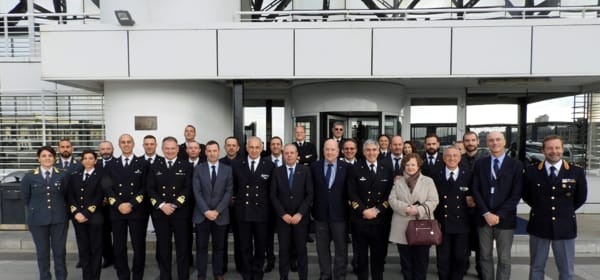
From 19 to 23 November 2018 the European Commission conducted an inspection at the Port of Trieste in order to monitor the correct implementation by Italy of the rules on maritime security both for ships and port facilities (Regulation 725/2004) and for the entire port area (Directive 2005/65 / EC).
The maritime security activity was born in 2006 by the will of the member states of the European Union, as a harmonized system of prevention and protection of ships and port facilities against threats of intentional unlawful acts; it is also based on the determinations already taken at international level by the International Maritime Organization (IMO) following the attack on the Twin Towers (adoption of the new Chapter XI-2 at the SOLAS'74 Convention and the International Ship and Port Security Code ).
The team of the EMSA Commission (European Maritime Safety Agency) on a mission to Trieste, made up of seven inspectors of different nationalities, has identified for the "port security" activity the entire port area and three specific facilities (port facilities), while for the "ship security" part, four ships of different nationalities, one from the non-EU, two from the Community and one from Italy were inspected.
The results of the inspection were extremely positive and the representative leader of the European Commission, in his closing speech, praised both the Coast Guard - who acted in the dual role of Competent Authority (General Command of the Corps of the Port Authority) and Designate (Port Authority), as well as with its own inspectors on board of the units inspected (Duly Authorized Officers) - both for the Prefecture, the Border Police, the Port Authority and all the other administrations that, in various capacities , participate in the implementation of the sector legislation.
On the occasion of this inspection, the assessment document produced in the framework of the SECNET project was further re-used and, given the results achieved, was very useful for the overall assessment of the security status of the Port of Trieste. For the first time, the CIO (Chief Information Officer) of the ADSP MAO was directly involved, explaining the components of the document and of the developments following the drafting, which was highly appreciated by the Commission, to the point that the Commission's leader affirmed that "the results of the inspection of one of the port facilities will be exported as best practice to the other Member States".
Thanks to the SECNET project, the Safety and Security Department of AdSP MAO has in fact been able to deepen the issues related to security and cyber security by creating a detailed assessment document ("Safety Evaluation of the Port of Trieste - Attachment 4 In-depth analysis, Cyber Risk Management "), which constitutes the de facto state of the Port of Trieste. This document has been reused by the DPO (Data Protection Officer) of the MAO AdSP for the preparatory steps for the requirements for the application of the GDPR (Regulation (EU) 2016/679), which fall within the scope of the pilot action of cyber security (A.3.1.4) of the SECNET project. The project has thus made it possible to reduce the internal workload and maximize efficiency in achieving these important security objectives.
But the SECNET activities have also allowed the MAO AdSP to acquire the know-how necessary for the management of a critical technological infrastructure such as SINFOMAR, the Port Community System of the Port of Trieste. The skills developed in this way were an important preparation for the application and compliance with the rules set by the NIS Directive (Directive (EU) 2016/1148).
| Visita EMSA al Porto di Trieste.pdf ( 112 bytes, published on 12 February, 2019 - 15:11 ) |